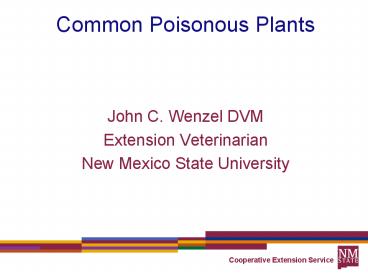Common Poisonous Plants PowerPoint PPT Presentation
1 / 20
Title: Common Poisonous Plants
1
Common Poisonous Plants
- John C. Wenzel DVM
- Extension Veterinarian
- New Mexico State University
2
Common Poisonous Plantsgoldenrod
3
Common Poisonous Plantsgoldenrod
- Toxin- Tremetol
- Toxic dose-1.5 of bodyweight over a period of a
week - Dried plants are not as toxic
4
Common Poisonous Plantsgoldenrod
- Clinical signs- depression
- reluctance to move
- muscle tremors
- downers
- death
- Treatment- supportive care
- Dont drive cattle that show signs
5
Common Poisonous Plantstansy mustard
6
Common Poisonous Plantstansy mustard
- Two syndromes
- Neurologic form
- Blindness- partial or complete
- Inability to use tongue
- Liver disease and photosynthesis
7
Common Poisonous Plantstansy mustard
- No specific toxin identified
- Treatment- remove from pasture and feed in corral
for a couple of weeks
8
Common Poisonous PlantsMesquite
9
Common Poisonous Plantsmesquite
- No specific toxin identified
- Seeds and pods form a sticky mass in rumen and
can cause a rumen impaction - Prolonged consumption can cause neurologic signs
10
Common Poisonous Plantsmesquite
- Clinical signs- weight loss, poor appetite,
frothy salivation, emaciation, loss of rumen
activity, intestinal obstruction - Neurologic signs- difficulty with chewing and
eating, masseter muscle atrophy - Horses are especially susceptible to mesquite
bean impaction
11
Common Poisonous Plantslocoweed,rattleweed
12
Common Poisonous Plantslocoweed, rattleweed
- Toxin- three types swainsonine
-
-nitroglycosides - -selenium
toxicity - Clinical signs- depends on toxin type
- swainsonine- depression, wobbly gait,
behavioral changes, incoordination, circling,
weight loss, inability to eat
13
Common Poisonous Plantslocoweed, rattleweed
- nitroglycosides- respiratory difficulty, weight
loss, wobbly gait, knuckling over of the fetlock
joints, hindleg weakness and paralysis,
recumbency and death - selenium toxicity- chronic-(alkali disease)
- lameness, hairloss, blindness, head pressing,
hair and hoof abnormalities (bobtail), repro
failures, liver cirrhosis and heart atrophy
14
Common Poisonous Plantslocoweed, rattleweed
- Horses are affected worse than cattle
- Treatment- remove from pasture and feed in
corral (6 to 12 months) - Once vacuoles are formed in the brain, they do
not go away
15
Common Poisonous Plantsbroom snakeweed
16
Common Poisonous Plantsbroom snakeweed
- Toxins- steroids, terpenoids, saponins and
flavones - Triterpene saponins are thought to be the
principle toxin of snakeweed - Clinical signs- poor appetite, weight loss,
diarrhea then constipation, liver abnormalities,
abortion, weak near term calves that die shortly
after birth, retained placentas and udder edema
17
Common poisonous plantsbroom snakeweed
- Treatment- remove from pasture and treat
symptomatically
18
Common poisonous plantsother plants
- Cyanogenic plants- cyanide poisoning
- Signs- sudden death, rapid breathing, foaming
at mouth, dilated pupils, ataxia, convulsions and
muscle tremors - Treatment- difficult- sodium nitrite and
sodium thiosulfate IV - Cyanogenic plants- catclaw, flax, johnsongrass,
sudan grass, common vetch, others
19
Common Poisonous Plantsother plants
- Nitrate plants nitrate toxicity- nitrate
converted to toxic nitrite - Clinical signs- weakness, muscle tremors,
increased heart and respiration rates,
staggering, downer and death - Treatment- methylene blue- difficult to find
- Nitrate plants- ragweed, lambs-quarter, kochia,
clover, johnson and sudan grass, filaree,
goldenrod, oats, wheat, corn, others
20
Questions?
- THANKS!!

